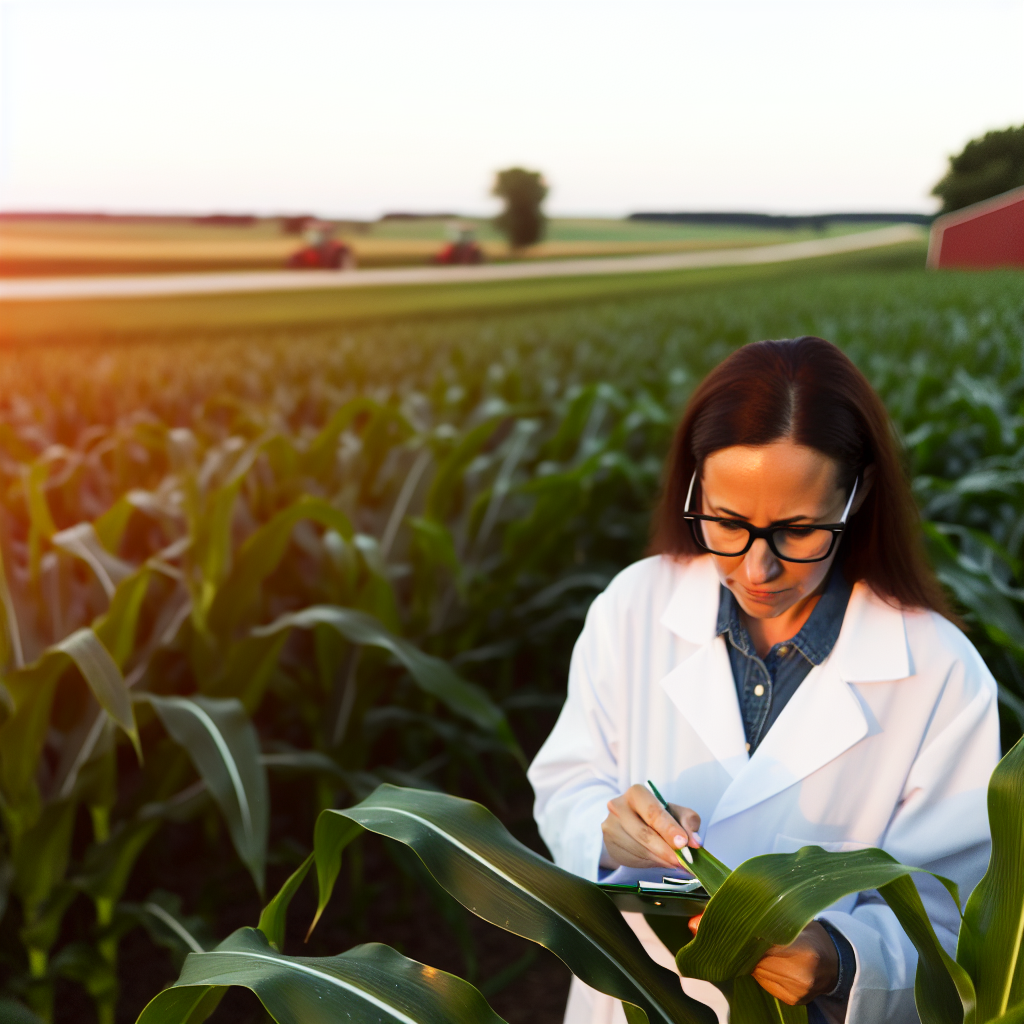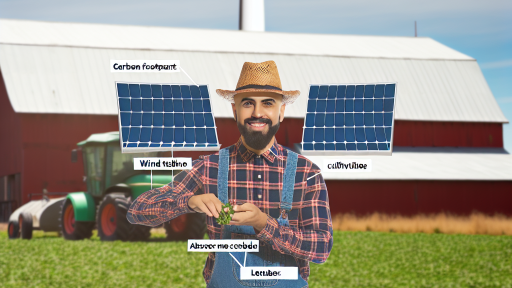Overview of Climate Change and Its Impact on Agriculture
Climate change significantly affects agriculture worldwide.
Rising temperatures lead to altered growing seasons.
Increased frequency of extreme weather events impacts crop yields.
Consequently, farmers face challenges in maintaining productivity.
Changing Weather Patterns
Weather patterns are becoming increasingly unpredictable.
Farmers must adapt to changes in rainfall and temperature.
For example, droughts can devastate crops in dry regions.
In contrast, excessive rainfall can lead to flooding and soil erosion.
Soil Degradation
Climate change accelerates soil degradation.
It reduces the soil’s ability to retain nutrients and water.
This degradation negatively impacts crop quality and yields.
Therefore, sustainable soil management practices are essential.
Pest and Disease Impacts
Warmer temperatures can increase pest populations.
Farmers must deal with more frequent crop infestations.
Additionally, shifts in climate can introduce new diseases.
Transform Your Agribusiness
Unlock your farm's potential with expert advice tailored to your needs. Get actionable steps that drive real results.
Get StartedThis situation requires farmers to implement effective pest control measures.
Economic Consequences
Declining crop yields lead to economic instability for farmers.
Food prices may increase as supply diminishes.
Communities that rely on agriculture face significant economic challenges.
Support for agricultural adaptation strategies is crucial now.
Key Climate Risks Affecting Crop Yields
Temperature Extremes
Temperature extremes significantly influence crop productivity.
High temperatures can lead to heat stress for plants.
Heat stress affects flowering, fruit set, and overall yield.
Additionally, chilling temperatures during critical growth periods can be damaging.
The resulting crop failure has severe economic consequences.
Farmers must adapt planting schedules to mitigate these risks.
Droughts
Droughts pose a major threat to agriculture globally.
Insufficient moisture levels slow crop growth and reduce yields.
As a result, drought decreases food availability and farm income.
Farmers may resort to irrigation practices to combat drought effects.
However, increased reliance on water can strain local resources.
Sustainable practices are vital to maintaining soil moisture levels.
Floods
Floods disrupt agricultural practices and yield stability.
Excess water can drown crops and damage root systems.
Moreover, flooding can lead to soil erosion, severely degrading land.
Farmers face significant challenges in managing flooded fields.
Crop recovery is often slow, affecting harvest times and profits.
Implementing effective drainage systems can help mitigate flood impacts.
The Role of Soil Health in Mitigating Climate Risks to Crop Production
Understanding Soil Health
Ssoil health directly influences crop resilience against climate change.
Showcase Your Farming Business
Publish your professional farming services profile on our blog for a one-time fee of $200 and reach a dedicated audience of farmers and agribusiness owners.
Publish Your ProfileHealthy soil promotes better water retention and nutrient availability.
As a result, crops can withstand extreme weather events better.
Moreover, diverse soil organisms enhance the overall ecosystem’s functionality.
Importance of Organic Matter
Organic matter serves as a critical component of healthy soil.
It improves soil structure, which enhances water infiltration.
Furthermore, organic matter facilitates nutrient exchange between plants and soil.
Increasing organic matter helps mitigate drought effects on crops.
Soil Microorganisms and Crop Health
Microorganisms play a vital role in soil health and fertility.
They break down complex organic materials into accessible nutrients.
This process supports plant growth and enhances resistance to pests.
In turn, healthier plants are less susceptible to climate-induced stress.
Crop Rotation and Soil Fertility
Crop rotation is an effective practice to enhance soil health.
Diverse crops improve soil structure and fertility over time.
Rotating crops can disrupt pest cycles, reducing chemical dependency.
Consequently, this practice promotes sustainable agricultural methods.
Cover Crops and Soil Conservation
Using cover crops benefits soil health significantly.
They prevent soil erosion during off-seasons while enhancing nutrient cycling.
Additionally, cover crops suppress weeds and improve soil biodiversity.
In turn, this fosters more resilient agricultural systems.
Conservation Tillage Practices
Conservation tillage enhances soil health by minimizing disturbance.
This method preserves soil structure and organic matter levels.
Moreover, it supports water conservation, reducing irrigation needs.
Ultimately, conservation tillage helps mitigate crop losses during droughts.
Benefits of Healthy Soil for Crop Yields
Healthy soil directly translates to increased crop yields.
Products from healthy soils are often more nutrient-rich and flavorful.
Furthermore, farmers benefit economically from better yields and lower costs.
As climate risks escalate, investing in soil health becomes essential.
Gain More Insights: Cover Crops and Their Role in Gas Mitigation
Economic Implications of Crop Yield Declines Due to Climate Change
Overall Economic Impact
Crop yield declines significantly affect economies around the world.
Farmers face reduced incomes, leading to financial instability.
Consequently, local economies that depend on agriculture suffer as well.
Additionally, food prices increase, impacting consumers.
This creates strain on household budgets, particularly for low-income families.
Agricultural Sector Challenges
The agricultural sector experiences multiple challenges due to climate change.
Farmers may need to invest in new technologies and practices to adapt.
However, these investments can be costly and may not yield immediate returns.
Moreover, smaller farms struggle more than larger operations.
This disparity can lead to a decline in smallholder farming.
Employment Effects
Crop yield declines lead to significant job losses in agriculture.
Workers in affected regions may find it harder to secure employment.
Showcase Your Farming Business
Publish your professional farming services profile on our blog for a one-time fee of $200 and reach a dedicated audience of farmers and agribusiness owners.
Publish Your ProfileFurthermore, this can result in increased migration to urban areas.
Consequently, urban centers may face challenges in housing and employment.
Global Trade Implications
Global trade dynamics shift as crop yields decline.
Countries that rely heavily on agricultural exports face economic risks.
These nations may experience a decrease in foreign currency earnings.
This can weaken their economic stability and growth prospects.
Long-Term Policy Considerations
Policymakers must consider long-term strategies to address these declines.
Investment in research and development can foster agricultural innovation.
Moreover, supporting sustainable farming practices is essential.
Regulations should encourage the adoption of climate-smart approaches.
This proactive stance can help mitigate future economic impacts.
Explore Further: Building Resilient Farms Against Climate-Induced Floods
Adaptive Strategies for Farmers
Crop Diversification
Crop diversification reduces risks associated with climate change.
Farmers can grow various crops to maintain yields.
Additionally, it enhances soil health and biodiversity.
Rotating crops helps to mitigate pest and disease issues.
Farmers can also choose drought-resistant varieties.
This strategy adapts to changing weather patterns and water availability.
Moreover, planting cover crops can improve soil structure.
Cover crops reduce erosion and increase organic matter.
Sustainable Practices
Implementing sustainable practices is crucial for long-term success.
Farmers can adopt integrated pest management techniques.
This approach minimizes pesticide use and boosts crop resilience.
Conservation tillage protects soil and conserves moisture.
It reduces soil compaction and erosion from heavy machinery.
Water management strategies can maximize irrigation efficiency.
Utilizing rainwater harvesting can reduce dependency on local water supplies.
Furthermore, organic farming practices enhance ecosystem health.
Collaboration and Education
Collaboration among farmers strengthens community resilience.
Sharing knowledge and resources leads to better decision-making.
Participating in workshops can enhance agricultural skills.
Farmers should engage with local agricultural organizations.
These connections can provide access to valuable resources.
Additionally, promoting involvement in research can lead to innovative solutions.
Find Out More: Adapting Agriculture to Climate Change Effectively

Technological Innovations in Agriculture to Combat Climate Risks
Precision Agriculture
Precision agriculture uses technology to enhance crop management.
Farmers utilize GPS and remote sensing to monitor fields.
This approach allows for efficient resource use and improved yields.
Moreover, it enables timely interventions during extreme weather events.
Drought-Resistant Crop Varieties
Developing drought-resistant crops is crucial for climate resilience.
Showcase Your Farming Business
Publish your professional farming services profile on our blog for a one-time fee of $200 and reach a dedicated audience of farmers and agribusiness owners.
Publish Your ProfileScientists engineer plants to withstand prolonged dry conditions.
These varieties require less water, ensuring better survival rates.
As a result, farmers can maintain yields even in drought conditions.
Climate-Smart Farming Techniques
Climate-smart farming helps adapt to changing weather patterns.
This includes implementing crop rotation and cover cropping strategies.
These practices enhance soil health and reduce erosion risks.
They also promote biodiversity, benefiting the entire ecosystem.
Automated and Controlled Environment Agriculture
Automated systems in greenhouses optimize growing conditions.
These technologies manage light, temperature, and humidity effectively.
As a result, crops can thrive regardless of external climate conditions.
Additionally, vertical farming maximizes space and water efficiency.
Data Analytics and AI in Agriculture
Data analytics and artificial intelligence drive decision-making in agriculture.
Farmers analyze data for insights on crop performance and weather patterns.
AI models predict potential risks, allowing proactive measures.
Ultimately, these technologies boost productivity and sustainability.
You Might Also Like: Farming Resilience: Adaptation Strategies That Work
Case Studies: Regions Most Affected by Climate Risks and Crop Yield Declines
Africa
Africa faces significant challenges due to climate change.
Rising temperatures threaten agriculture across the continent.
For example, East African countries experience increased droughts.
This leads to reduced yields in staples like maize and sorghum.
Farmers like Amina Mwangi struggle to adapt to these changes.
South Asia
South Asia is vulnerable to extreme weather events.
Flooding and heatwaves disrupt farming operations.
The monsoon season has become unpredictable.
Consequently, rice and wheat yields fluctuate dramatically.
Local farmers often face crop failures during these events.
Central America
Central America has a history of climate-related crop losses.
Hurricanes and heavy rainfall destroy harvests annually.
For instance, coffee plantations in Honduras suffer severe damage.
This impacts local economies and livelihoods significantly.
Farmers like Carlos Ramos struggle to recover from these events.
Europe
Europe also experiences climate risks affecting crop yields.
In southern regions, droughts threaten olive and grape production.
These changes impact wine and oil industries extensively.
Farmers like Elena Russo adapt by diversifying their crops.
However, the long-term impacts are still uncertain.
North America
North America faces varying climate challenges across its regions.
The Midwest experiences intense storms and flooding.
This disrupts corn and soybean production significantly.
Additionally, the western states struggle with prolonged droughts.
Showcase Your Farming Business
Publish your professional farming services profile on our blog for a one-time fee of $200 and reach a dedicated audience of farmers and agribusiness owners.
Publish Your ProfileFarmers such as James Thompson turn to conservation practices.
These practices aim to build resilience against climate change.
Policy Measures and Government Support for Climate Resilience in Agriculture
Importance of Climate Resilience
Climate resilience is vital for sustaining agricultural productivity.
Farmers face numerous challenges due to climate change.
Adaptation strategies help maintain crop yields and food security.
Government Policies Enhancing Resilience
Governments are increasingly recognizing the need for effective policies.
Subsidies for climate-adaptive farming practices are becoming more common.
These policies encourage farmers to invest in resilient technologies.
Funding Mechanisms
Many countries implement financial support programs for farmers.
Grants and loans are available for sustainable farming initiatives.
These financial instruments help mitigate risks associated with climate variability.
Research and Development Initiatives
Investments in agricultural research are critical for resilience.
Governments fund studies on drought-resistant and flood-tolerant crops.
This research leads to innovative solutions for farmers facing climate threats.
Community and Cooperative Support
Local communities play a significant role in building resilience.
Cooperatives provide shared resources and knowledge among farmers.
These networks enhance collective decision-making regarding crop management.
Educational Programs
Governments promote educational initiatives for farmers.
Workshops and training sessions help disseminate climate-smart practices.
Farmers gain valuable knowledge to adapt to changing conditions.
Collaboration with NGOs
Collaboration between government and NGOs fosters resilience.
NGOs often provide on-the-ground support and resources.
This partnership enhances the effectiveness of resilience strategies.
Monitoring and Evaluation Efforts
Governments implement monitoring systems to track progress.
Regular assessments help refine strategies and policies.
Data-driven approaches ensure that resources are allocated effectively.
Impact Assessment Frameworks
Frameworks for assessing the impact of resilience measures are essential.
They evaluate the effectiveness of various government initiatives.
This feedback loops into policy adjustments for continuous improvement.
Additional Resources
Global vulnerability of crop yields to climate change – ScienceDirect




